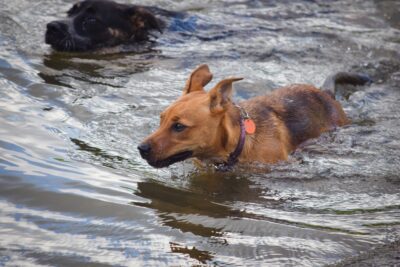BY AMANDA MELNYK ’09, AS, CVT
Originally published in the July 22, 2022, edition of the Valley Advantage.
Summer is upon us, and one of the great benefits of living in NEPA is being outdoors and enjoying all the natural beauty our area offers.
Not only do we love to spend time in nature, but so do our furry counterparts! Although nature has countless benefits, there can be danger lingering in our water sources. This life-threatening concern for our beloved pets is known as Cyanobacteria (previously known as blue-green algae), also referred to as HABs or harmful algal blooms. As a concerned pet parent, you need to know how to deal with this problem, so let’s get to the details!
Our first question is, “What is Cyanobacteria?”
Although referred to as algae, Cyanobacteria or HABs, are a type of microscopic bacteria that occur throughout the country. There are multiple species of Cyanobacteria, and these organisms can resemble algae when clumped together in bodies of water. It is important to note that some species have the potential to become HABs that produce toxins, while others do not, and concentrations vary throughout the year and therefore may not always be harmful.
The algae that become toxic undergoes a period of rapid growth in calm/still bodies of water when an abundance of nutrients is available during the warmer months when water temperatures are high. More than 30 species of Cyanobacteria can produce four types of toxins that can damage the nervous system, skin, kidneys or liver. Unfortunately, results are most commonly fatal.
“How do I know where it is safe for my pet,?” is our second question.
These toxic algae blooms can be found in many places, including fresh water, salt water, backyard pools and ponds, if not cleaned regularly. Observing the following signs is helpful when looking for a safe place to cool down with your pet, but lab analysis is needed to confirm HABs in a suspected body of water. Due to the severity of HABs to your pet’s health, it is better to avoid the area altogether.
That being said, some toxic algae blooms can be blue-green, some red and brown and others can resemble paint floating on top of the water.
Another way to help identify this toxin is a slimy or foamy “scum” or mat appearance on the surface of the water or shoreline. Also, keep in mind that some (not all) toxic algae may produce a foul odor. Dead fish or other dead wildlife in a body of water can also be a warning sign. Other helpful advice is to keep an eye out for HABs watch, advisory or warning signage from official agencies.
Our third question is, “What do I do if I suspect my pet ingested or came in contact with HABs?”
First, if applicable, thoroughly rinse your pet off in fresh water, but also be sure to wear gloves to protect yourself! Next, seek veterinary help immediately. Symptoms can arise anywhere from 15 minutes to several days post-exposure. Some symptoms may include staggering, drooling, diarrhea, vomiting, weakness, difficulty breathing or seizures. It is crucial that you seek professional veterinary care! Afterward, it is recommended to report the suspected bloom to your state’s health department to aid other animals and their owners avoid this frightening event.
Multiple resources are available if you want to learn more about Cyanobacteria and how to keep you and your pets safe while having fun in the water this summer. We suggest reviewing the HABs page on Pennsylvania’s Department of Environmental Protection website, dep.pa.gov. The Pennsylvania HABs Task Force, which includes representatives from the Pennsylvania Department of Environmental Protection, the Pennsylvania Department of Health, the Pennsylvania Department of Conservation and Natural Resources, the Pennsylvania Department of Agriculture, the Pennsylvania Fish and Boat Commission, the Pennsylvania Game Commission and the Pennsylvania Emergency Management Agency. You can also contact your veterinary offices, which can supply valuable information.
Have fun this summer, be safe and always look before you — or your pets — leap into the water.
Amanda Melnyk, ’09, AS, CVT, ’is a full-time CVT instructor at Johnson College’s veterinary nursing program as well as a clinical rotation instructor at Johnson College’s Animal Care Center on campus. She has been a part of the veterinary field for 14 years.

